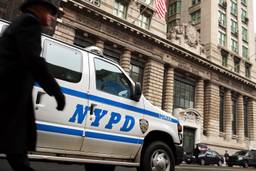Over the course of the past three months, Occupy camps nationwide have been the scenes of sometimes brutal crackdowns by police on protesters, who have tried to exercise their First Amendment rights to gather and express themselves.
The raids have also permitted officers to experiment with their favorite toys of suppression. The use of pepper spray, rubber bullets, tasers, flash bang grenades, tanks (see: Occupy Tampa,) tear gas, and batons are familiar sights to most Occupiers by now.
NYPD used a Long-Range Acoustic Device, commonly known as a sound cannon, primarily as a “communication device” even though the LRAD can easily damage hearing. The LRAD was also used during a raid at Occupy LA.
For more than 90 days, some protesters desperately clung to the world’s most uneven battlefield in which police officers, armed with millions of dollars worth of weaponry – sometimes purchased with funding from the big banks themselves – repeatedly raided their camps.
And contrary to what the new Batman trailer might claim, Occupiers aren’t armed to the teeth with assault firearms. In other words, this is far from a fair fight. The best OWS can hope for is some entrepreneuring mind to come along and help them gain a strategical edge against police forces sporting the latest in cutting edge surveillance equipment.
Tim Pool, an OWS protester, has acquired a Parrot AR drone he calls the “occucopter.”
It is a lightweight four-rotor helicopter that you can buy cheaply on Amazon and control with your iPhone. It has an onboard camera so that you can view everything on your phone that it points at. Pool has modified the software to stream live video to the internet so that we can watch the action as it unfolds. You can see video clips of his first experiments here. He told us that the reason he is doing this “comes back to giving ordinary people the same tools that these multimillion-dollar news corporations have. It provides a clever loophole around certain restrictions such as when the police block press from taking shots of an incident.”
Pool is attempting to police-proof the device: “We are trying to get a stable live feed so you can have 50 people controlling it in series. If the cops see you controlling it from a computer they can shut you down, but then control could automatically switch to someone else.”
Pool is now working on a 3G controller so that “you could even control the occucopter in New York from Sheffield in England.” He believes, perhaps naively, that the NYPD won’t destroy the drone because “they can’t just fire a weapon in the air because it could seriously hurt someone.”
The idea behind all of this is to – at the risk of making a second comic book reference in the span of a single article – watch the Watchmen. Police hold an advantage over protesters because they are able to monitor their every waking moment. Now, Occupy has a small, modest way to watch them back.
However, as the race to militarize police rushes forward, Occupiers will find it impossible to compete with forces that are being rapidly armed with the latest tools in crowd suppression.
For example, sound cannon sales are booming following their deployments at OWS and G-20 protests.
More U.S. police and emergency-response agencies are using the so-called Long-Range Acoustic Devices instead of megaphones or conventional loudspeakers for crowd control, according to news reports and leading manufacturer LRAD Corp. of San Diego.
Then there’s the invention of new, terrifying-sounding weaponry, which if sold to police forces, will no doubt first be tested on protesters – because this stuff is always tested on protesters first – in the laboratory known as Occupy.
It’s not the first crowd control tool to use sound waves, but Raytheon’s patent for a new type of riot shield that produces low frequency sound waves to disrupt the respiratory tract and hinder breathing, sounds a little scary.
Crowd control tools like the LRAD Sound Cannon emit bursts of loud and annoying sounds that can induce headaches and nausea. But Raytheon’s non-lethal pressure shield creates a pulsed pressure wave that resonates the upper respiratory tract of a human, hindering breathing and eventually incapacitating the target. The patent points out that the sound waves being generated are actually not that powerful, so while protestors might collapse from a lack of oxygen reaching their brains, their eardrums won’t be damaged in the process. Phew!
These shields can be networked together to form one big, giant acoustical horn, which vastly improves their “range, power, and effectiveness.”
We don’t yet know the long-term health consequences of finding one’s self on the wrong side of these shields, but Raytheon is, of course, stressing the non-lethalness of its new product - as the makers of LRADS, tasers, and pepper spray all stress the non-lethalness of their merchandise.
Although, to his credit, Kamran Loghman, the expert who developed pepper-spray, expressed shock at how police have used the spray against non-violent Occupy protesters.
Of course, when a “battlefield” is this uneven – one side holding all the weapons, and the other side possessing only a meager attempt at surveillance (a single drone, Twitter, livestreams, etc.) – Occupy obviously couldn’t match the brute strength of police, which is why the major camps are gone now and the movement has gone “underground.”
Occupy actions still exist, but they are now indoor occupations performed by splinter cells. Thus far, the plan appears to be continued resistance until the warmer months when OWS can regroup and surge forth again.




